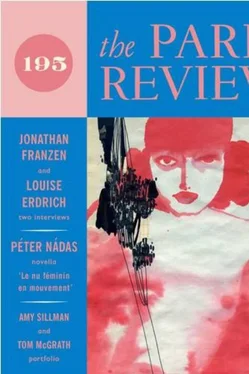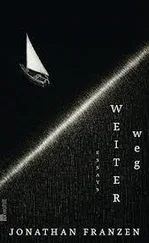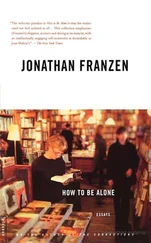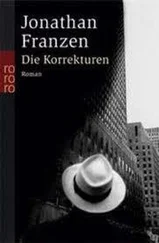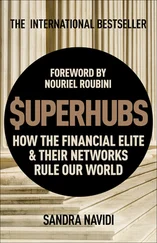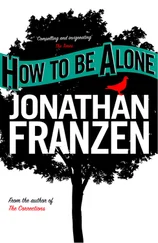Jonathan Franzen - How He Came to Be Somewhere - An Interview and Three Early Stories
Здесь есть возможность читать онлайн «Jonathan Franzen - How He Came to Be Somewhere - An Interview and Three Early Stories» весь текст электронной книги совершенно бесплатно (целиком полную версию без сокращений). В некоторых случаях можно слушать аудио, скачать через торрент в формате fb2 и присутствует краткое содержание. Город: New York, Год выпуска: 2010, ISBN: 2010, Издательство: The Paris Review, Жанр: Современная проза, Публицистика, на английском языке. Описание произведения, (предисловие) а так же отзывы посетителей доступны на портале библиотеки ЛибКат.
- Название:How He Came to Be Somewhere : An Interview and Three Early Stories
- Автор:
- Издательство:The Paris Review
- Жанр:
- Год:2010
- Город:New York
- ISBN:9780857861740
- Рейтинг книги:4 / 5. Голосов: 1
-
Избранное:Добавить в избранное
- Отзывы:
-
Ваша оценка:
- 80
- 1
- 2
- 3
- 4
- 5
How He Came to Be Somewhere : An Interview and Three Early Stories: краткое содержание, описание и аннотация
Предлагаем к чтению аннотацию, описание, краткое содержание или предисловие (зависит от того, что написал сам автор книги «How He Came to Be Somewhere : An Interview and Three Early Stories»). Если вы не нашли необходимую информацию о книге — напишите в комментариях, мы постараемся отыскать её.
How He Came to Be Somewhere : An Interview and Three Early Stories — читать онлайн бесплатно полную книгу (весь текст) целиком
Ниже представлен текст книги, разбитый по страницам. Система сохранения места последней прочитанной страницы, позволяет с удобством читать онлайн бесплатно книгу «How He Came to Be Somewhere : An Interview and Three Early Stories», без необходимости каждый раз заново искать на чём Вы остановились. Поставьте закладку, и сможете в любой момент перейти на страницу, на которой закончили чтение.
Интервал:
Закладка:
INTERVIEWER
When did you first come across DeLillo?
FRANZEN
I remember a Christmas visit to my wife’s family during which she gave me Players . I remember reading it on the train back up to Boston and having one of the purest aesthetic responses I’ve ever had. I’d finally found somebody who was putting on the page the apocalyptic, postindustrial urban aesthetic that I’d been looking for in film and photographs and had found expressed in music, particularly by Talking Heads. And here was somebody who was getting it on the page and writing like a dream. His prose was like a call to duty: You must write better. Here, see, it can be done. I find it remarkable that people don’t talk more about Players . In certain ways, DeLillo never wrote better.
INTERVIEWER
What did you find so attractive about him?
FRANZEN
It came as no surprise when I learned, later, that he sometimes composed books with one paragraph on each page, starting a new page after only a few sentences. His paragraphs really do have a stand-alone quality. It was through reading him that I came to see pages as collections of individual sentences. For a young writer, in particular, the terrors of the paragraph become more manageable when you see it as a system of sentences. I also started to see all the junk DNA that had cluttered my paragraphs before then, and that I’d been unaware of.
INTERVIEWER
DeLillo’s sentences seem to involve intimate connections between individual words, even letters — a visual patterning.
FRANZEN
Yes. In my own work, I can see his visual influence in the dinner-table scene in The Corrections that I wrote immediately after reading Underworld . But I don’t think my pages read like his, because I had a preference for rounder letters— c ’s and p ’s. I think of him as being more into l ’s and a ’s and i ’s.
INTERVIEWER
C ’s and p ’s?
FRANZEN
I kept seeing a plate of food with beet greens and liver and rutabaga — intense purple green, intense orange, rich rusty brown — and feeling a wish to write sentences that were juicy and sensuous.
INTERVIEWER
Do you mean the sound, too?
FRANZEN
No, the way they looked, the roundness of b ’s and g ’s, the juiciness. That’s almost the last time I remember thinking about the words that way. Nowadays I have almost the opposite aesthetic — I’m looking for transparency.
INTERVIEWER
And when did you discover Pynchon?
FRANZEN
I’d come up with the plot of The Twenty-Seventh City when I was a college sophomore, in a playwriting workshop, and our instructor had told me I’d better take a look at Pynchon. I finally got around to it after I graduated and went back to Germany. I took Gravity’s Rainbow along in mass-market paperback, and it utterly consumed me. It was like getting the flu to read that book. It was like I was fighting off some very aggressive infection. I started writing Pynchonian letters to my then-fiancée, and I think it’s significant that she hated those letters and made her hatred of them known, and that I steered away from that voice — because of our relationship, because of an intense relationship with a woman. Which now seems to me emblematic: You could either play with the boys like that, and relegate women to minor and substantially objectified characters on the margin, or you could try to have a full-fledged relationship with a woman, in which case that kind of boy writing, however brilliant and masterful, was necessarily subordinate. It’s worth noting that at this point in my life, I feel much more indebted to various female writers — Alice Munro, Christina Stead, Flannery O’Connor, Jane Smiley, Paula Fox, to name a few — than I do to Pynchon.
INTERVIEWER
What about the letters was Pynchonian?
FRANZEN
The tangly sentences, the overfullness of them, and a kind of dirty explicitness. A hipster jadedness. “Seen it all, done it all, don’t mean shit.” Like the dark side of R. Crumb.
And yet Pynchon’s enterprise in that book — creating an immensely complex world in which conspiracy is the organizing principle — was something I internalized and tried to build on. I saw that I might be able to go beyond the unseen conspiracy to a seen conspiracy, inhabited by complicated characters with whom we might, moreover, sympathize. To turn the whole notion of the victim of conspiracy inside out and make the victim himself a problematic figure and the conspirators perhaps well justified. That was my best shot, as a twenty-three-year-old, at dealing with my brief but life-threatening infection with Pynchon.
INTERVIEWER
And that infection did not last to your later novels?
FRANZEN
No. Even in my first book, I found a better model in Coover. He had some of the same satiric and encyclopedic ambitions as Pynchon, but he was working at the level of characters and their relationships to one another, and I just gravitated to that.
INTERVIEWER
You’ve described your first two books as “systems novels.”
FRANZEN
I had an idea of the social novel that I didn’t realize was already outmoded. I rather naively believed that, if I could capture the way large systems work, readers would understand their place in those systems better and make better political decisions. I’d taken real delight in the books of the previous generation that had revealed these kinds of systems to me. In The Twenty-Seventh City , the systems were city and county government and regional economics. And there were various systems in Strong Motion , most notably the systems of science and religion — two violently opposing systems of making sense in the world.
This conception of the novel, I think, came out of my engagement with science fiction, which is all about concepts. You have a cool idea: What if we could travel back in time? What if in the future there’s only one sex? And then the characters come into being to make that story happen. Going into my first two books, I did have several characters firmly stuck in my head, but many of the smaller characters were invented to serve the systems. Whereas, in my last two novels, the systems are there to serve the characters. There are lingering elements of the old method in The Corrections —I’d been fascinated, for example, by my parents’ stories of cruises and, like Dave Wallace, I saw the cruise ship as somehow emblematic of our time. But my priorities have mostly flipped.
INTERVIEWER
How did you begin to write Strong Motion ?
FRANZEN
A bunch of things had happened. My first book had been published, and my wife and I had fled to Europe; things were getting hard in the marriage. And, perhaps not coincidentally, I’d fallen under the spell of religious writers, particularly Flannery O’Connor and Dostoyevsky. My wife and I began touring cathedrals and looking at medieval sculpture and Romanesque churches. Wise Blood, The Brothers Karamazov , and the cathedral at Chartres are all examples of religious art, which is neither just religion nor just art; it’s a special category, a special binding of the aesthetic and the devotional. O’Connor and Dostoyevsky venture intensely into the extremes of human psychology, but always with serious moral purpose. Because of the difficulties in my marriage, I was attracted to their search for moral purpose in emotional extremity. I imagined static lives being disrupted from without — literally shaken. I imagined violent scenes that would strip away the veneer and get people shouting angry moral truths at each other. I had the title Strong Motion very early on.
Читать дальшеИнтервал:
Закладка:
Похожие книги на «How He Came to Be Somewhere : An Interview and Three Early Stories»
Представляем Вашему вниманию похожие книги на «How He Came to Be Somewhere : An Interview and Three Early Stories» списком для выбора. Мы отобрали схожую по названию и смыслу литературу в надежде предоставить читателям больше вариантов отыскать новые, интересные, ещё непрочитанные произведения.
Обсуждение, отзывы о книге «How He Came to Be Somewhere : An Interview and Three Early Stories» и просто собственные мнения читателей. Оставьте ваши комментарии, напишите, что Вы думаете о произведении, его смысле или главных героях. Укажите что конкретно понравилось, а что нет, и почему Вы так считаете.
